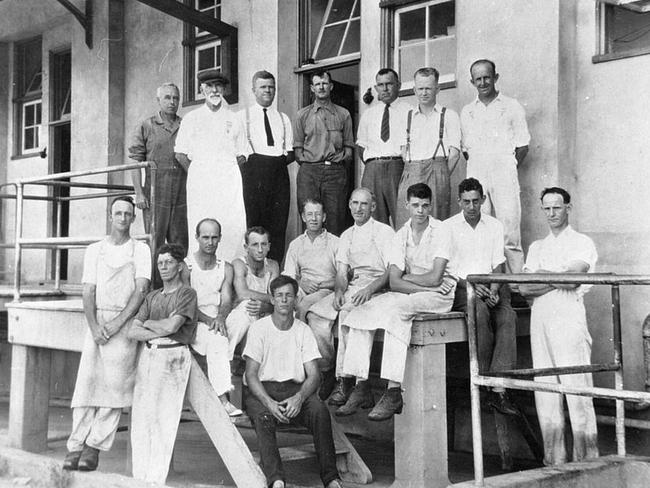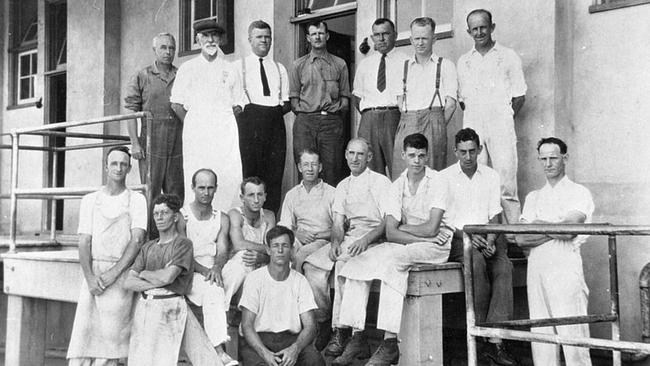Lismore history: Norco clocks over 127 years in business
Australia’s largest and oldest dairy cooperative is here for the long haul. Here is it’s history.

Lismore
Don't miss out on the headlines from Lismore. Followed categories will be added to My News.
Dairying and cedar cutting are the hallmarks of North Coast history.
The Richmond River district was seen as a fertile home for graziers who could run dairy production year round due to the tepid climate.
James Reeves is known to have established the area’s first ‘real’ dairy at his property at Fairy Hill, near Kyogle around 1870.
Milking was done by hand, and it was placed in flat dishes to set.
The best land was deemed to be by the rivers and by the 1880s graziers had established themselves across the Richmond River district and more were moving into the Brunswick and Tweed Valleys.
Norco began on June 5, 1895 as the North Coast Fresh Food and Cold Storage Co-Operative Company Ltd.
They chose Byron Bay as their base because the jetty had opened in 1888 and provided easy shipping and access to a world wide market.
Within two years the Byron Bay factory had seven separating stations supplying it, along with over 100 individual suppliers.
In 1904 the N.C.F.F. and C.S. Co-operative Ltd changed its name to Norco.
During this time there were several other co-operatives in the North Coast that later merged with Norco including the Ballina Co-operative, in 1929, and the Casino Dairy Co-operative which Norco bought in 1975.
The privately owned, NSW Creamery Butter Company Ltd, which was the original factory to be established on the North Coast, was bought out by the Lismore Co-operative Dairy Company.
Shortly after they too merged with Norco.
Foley Brothers Pty Ltd held a significant share in the region yet succumbed to Norco in 1958.
Early innovations
Early graziers experimented with a variety of grasses as the native grasses were unsuitable for heavy dairying.
In 1892 Edwin Seccombe imported some Japanese clover seed.
Together with then Mayor of Lismore, James Barrie and Lismore town clerk Charles Barham, the men planted some at the council chambers.
The grass grew with such vigour it required fencing off to prevent theft and within a few short years this became to major pasture grass on the North Coast.
Tuberculosis bacillus in milk was overcome with the aid of the NSW Creamery Butter Company Ltd factory in Lismore which had a pasteurising plant.
As farmers could also afford smaller separators and complete this task themselves it reduced the risk of transmitting the disease.
1901 saw the first private separator installed on the North Coast and within ten years there were around 5500.
The Babcock Tester was an excellent innovation which gauged the amount of butterfat in milk.
No longer could shady operators add water to their milk make a buck when their pay for product turned from quantity to quality.
Demand for improved product forced farmers to buy quality stock and improve their pastures.
1894 the NSW government created the Wollongbar Experimental Farm to determine which breeds would perform well, among other tasks.
The farm ran Shorthorn and Ayrshire herds similarly bred on the south coast and in 1915 the farm changed and kept until the 1950s, Guernseys.
Markets and Politics
North Coast dairy’s primarily produced milk by-products simply because of the distance to large population centres.
Trade with Britain during the war years had been fruitful yet product from Denmark was outperforming Australian imports, so the government introduced a series of industry regulations with the outcome to produce a more competitive product.
In 1915, a meeting of Norco shareholders established the Primary Producers Union (PPU) which grew into a statewide organisation with its district council based in Lismore.
North Coast dairy farmers wanted to enter the domestic milk market as it paid twice the amount compared to a cream supplier.
In 1929 the Metropolitan Milk Board was established to collect milk for distribution throughout the Sydney area.
In 1931 they changed the name to the Milk Board and a Milk Zone was set up for the Sydney region.
Zoning placed restrictions on areas which the milk could be supplied, denying North Coast farmers or factories permission to send their milk to the Milk Board, in effect stopping them from entering this market.
However the Milk Zone was starved of milk during winter and in 1949 Lismore’s Norco factory supplied them.
From 1951-1955 demand grew to see Norco supply the Zone around 151,416.47 litres of milk a week.
In 1970 the Milk Board was replaced by the Dairy Industry Authority (DIA) under new legislation, Dairy Industry Act 1970.
It managed registration of dairies, quality control, registration of milk vendors, supervision and distribution of product to artificial insemination to improve stock.
With this new body, bulk milk collection became compulsory.
Farmers were forced to upgrade their dairies to include refrigerated holding tanks making it near impossible for new suppliers to enter the industry.
1972 saw the Primary Produces Union along with the Australian Primary Producers Union merge to form the Dairy Farmers Association (DFA), set up solely to lobby and negotiate with the Dairy Industry Authority.
Not until 1976 did North Coast farmers receive their share of the metropolitan milk market.
With Labor winning the election in 1975, Norco was allocated a permanent quota, granting all year access to the Milk Zone.





